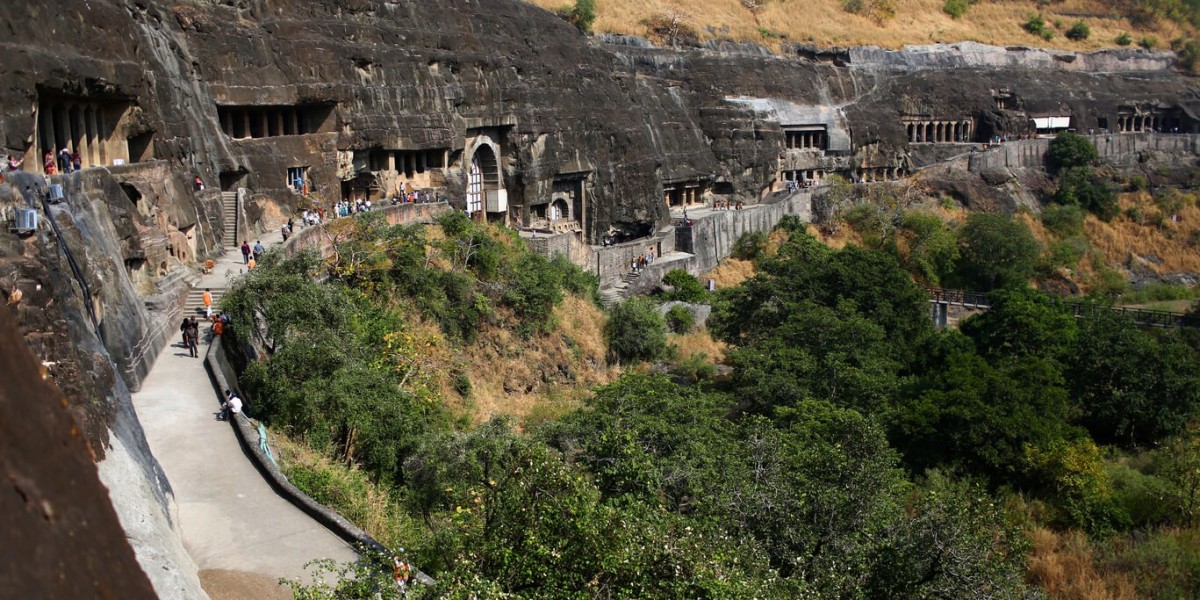The Ellora Caves, a UNESCO World Heritage site in Maharashtra, India, offer a fascinating glimpse into ancient architecture, art, and spirituality. This Ellora Caves guide takes you through the impressive rock-cut temples, monasteries, and shrines, spanning three major religions: Hinduism, Buddhism, and Jainism. The highlight is the Kailasa Temple (Cave 16), an architectural marvel carved from a single rock. The Buddhist caves (13-29) showcase serene sculptures, while the Jain caves (30-34) offer peaceful reflections of Jain philosophy. Located near Aurangabad, Ellora is best visited between October and March when the weather is cooler. A visit to the Ellora Caves is a must for anyone interested in India's rich cultural and religious heritage.
History and Significance of Ellora Caves
The Ellora Caves stand as one of the largest rock-cut monastery-temple complexes in the world, recognized as a UNESCO World Heritage Site. Carved directly into the rocky Charanandri Hills, the site consists of 34 caves stretching across nearly two kilometers. These caves were primarily constructed during the rule of the Rashtrakuta dynasty and reflect a harmonious blend of religious tolerance, as Hinduism, Buddhism, and Jainism coexisted peacefully.
The caves are classified into three groups based on the religions they represent:
Caves 1–12: Buddhist caves, showcasing stupas, shrines, and monastic dwellings.
Caves 13–29: Hindu caves, highlighting mythological narratives and complex sculptures.
Caves 30–34: Jain caves, symbolizing intricate craftsmanship and spiritual serenity.
Must-Visit Highlights of Ellora Caves
1. Cave 16: The Kailasa Temple
The Kailasa Temple in Cave 16 is one of the most breathtaking sights in the Ellora complex. Dedicated to Lord Shiva, this rock-cut temple is regarded as one of the most stunning examples of ancient Indian architecture. The entire structure is carved from a single monolithic rock, designed to mimic Mount Kailash, Shiva’s celestial abode. The Kailasa Temple is notable for its towering gopurams, intricate friezes, and elaborate reliefs depicting stories from Hindu epics like the Mahabharata and Ramayana. This cave alone is worth the visit to Ellora and remains one of the most photographed monuments in India.
2. Cave 10: The Vishvakarma Cave
Known as the Carpenter’s Cave, Cave 10 is the only Buddhist chaitya (prayer hall) in the Ellora complex. Its barrel-vaulted ceiling, with a rib-like structure carved into the stone to mimic wooden beams, has earned it the Carpenter’s Cave moniker. This cave houses a stunning 15-foot-tall seated Buddha in a meditative pose, surrounded by smaller carvings of the Buddha in various postures. The acoustics of this cave are particularly impressive, adding a unique auditory element to its sacred atmosphere.
3. Jain Caves (Caves 30–34)
The Jain caves in Ellora are smaller compared to the Buddhist and Hindu caves, yet they display an unparalleled intricacy and elegance. Caves 32 and 33, particularly, stand out with their carvings of the Jain Tirthankaras (spiritual teachers). The Indra Sabha (Cave 32) is one of the most beautifully adorned caves, featuring elaborate sculptures and highly detailed reliefs. Visitors often note the calm and peaceful ambiance of these caves, which contrast with the grandiosity of the Kailasa Temple.
Architecture and Art of Ellora Caves
The architecture of Ellora Caves is a marvel of ancient engineering and artistic vision. Created through the "cut-out" technique, craftsmen chiseled down from the top of the rock to the bottom, allowing for precision and uniformity. The intricate carvings reflect a mastery of technique, capturing dynamic movement, detailed facial expressions, and lifelike poses. Hindu caves often depict gods and goddesses in dramatic scenes, while Buddhist caves feature serene Buddhas and peaceful bodhisattvas, and Jain caves embody meditative tranquility.
Religious Syncretism at Ellora
Ellora is remarkable for being a religious syncretic site, where Hindu, Buddhist, and Jain shrines coexisted harmoniously. This unique aspect of Ellora highlights the cultural acceptance prevalent during its construction period. Visitors can observe how each religion's caves carry distinct features yet share common themes, such as respect for divinity, human life, and nature.
Travel Tips for Visiting Ellora Caves
Best Time to Visit
The ideal time to visit Ellora Caves is between October and March, when the weather is cooler and more comfortable for walking and exploring the expansive site. Avoid visiting during the peak summer months of April to June due to the high temperatures, which can make it challenging to navigate the caves comfortably.
Getting There
Ellora Caves are located approximately 30 kilometers from Aurangabad, which has both airport and train connectivity. Visitors can reach Aurangabad by flights or trains from major cities like Mumbai, Pune, and Delhi. From Aurangabad, you can hire a taxi or take a bus to the Ellora Caves, which takes around 45 minutes.
Entry Fees and Timings
The Ellora Caves are open every day except Tuesdays from 6:00 AM to 6:00 PM. For Indian citizens, the entry fee is relatively low, while foreign tourists may be required to pay a higher fee. Children below 15 years of age are admitted free of charge. Since the Kailasa Temple (Cave 16) is the most popular site within the complex, it is advisable to start early in the day to avoid crowds.
Guided Tours and Facilities
To make the most of your visit, consider hiring a licensed guide who can offer insights into the historical and cultural context of each cave. Audio guides are also available, providing a detailed narration of the site's highlights. The Archaeological Survey of India (ASI) maintains the site, and basic facilities such as restrooms and refreshment stalls are available near the entrance.
Nearby Attractions
1. Ajanta Caves
Located about 100 kilometers from Ellora, the Ajanta Caves are another UNESCO World Heritage Site and can be visited as part of a combined itinerary. Ajanta is famous for its ancient Buddhist paintings and sculptures and predates the Ellora Caves. The caves at Ajanta provide a deeper insight into the early development of Indian rock-cut architecture and are highly recommended for anyone interested in history and art.
2. Daulatabad Fort
The Daulatabad Fort, situated around 15 kilometers from Aurangabad, is a medieval fort known for its impressive defense mechanisms and unique architecture. The fort was once a strategic military base for various ruling dynasties and offers panoramic views of the surrounding landscape, making it an excellent addition to the Ellora tour.
3. Bibi Ka Maqbara
Popularly known as the "Mini Taj Mahal", Bibi Ka Maqbara is a stunning mausoleum built by the Mughal emperor Aurangzeb in memory of his wife. Located in Aurangabad, it showcases a blend of Mughal and Persian architectural styles and offers a peaceful setting for reflection.
Essential Tips for an Enriching Experience
Wear Comfortable Footwear: The Ellora Caves involve a fair amount of walking, with uneven surfaces, so sturdy and comfortable shoes are a must.
Carry Water and Snacks: Although there are refreshment stalls near the entrance, bringing your own water and light snacks will help you stay refreshed.
Respect the Sacred Spaces: Many of the caves are considered sacred, so be mindful of local customs and avoid touching or damaging the carvings.
Photography Restrictions: While photography is generally allowed, some areas may restrict flash photography. Be sure to check before taking photos.






